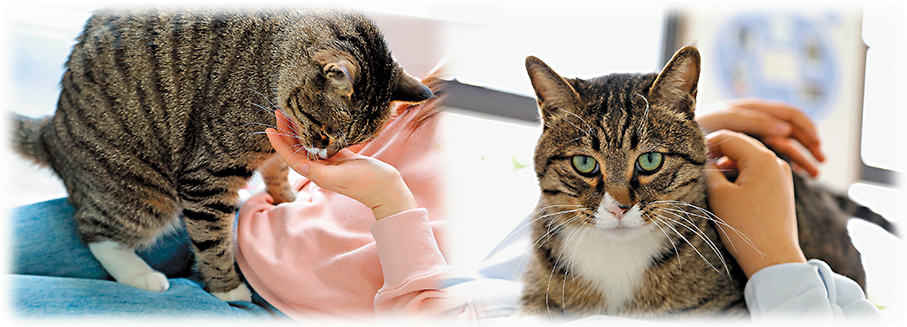

原文
摘錄自6月21日香港《文匯報》:一百多平方的大辦公室,散落着各式各樣的玩具,「方醫生」正在接診兩個青少年患者。不穿白大褂,不開處方。「方醫生」——一隻3歲小公貓,大名「方便袋」,是濟南智善心理醫院的一名動物輔助治療師,牠默默陪伴着來訪者,為他們提供一個溫暖、穩定的心理空間。
動物輔助治療(Animal-Assisted Therapy)是一種將動物融入特定治療計劃中的干預方式,近年來在內地得到了快速發展。「方便袋」是該院動物輔助治療項目的核心成員之一。自3月份開始接診,「方便袋」接診人次已經到達500人次以上,尤其擅長為18歲以下青少年提供情緒支持。
「貓和孩子之間不單是朋友關係,只是簡單地陪孩子玩一會兒,而是一種工作治療關係。」擔任「方醫生」助理的心理治療師馮傑解釋說,動物輔助治療中動物的角色不同於家養寵物或者貓咖式陪伴,這是一套有目標、有計劃、有反饋機制的專業干預系統,需要來訪者、動物醫生和心理治療師三方共同參與。
在「方醫生」和孩子們相處時,馮傑也坐在一邊留意細節。曾有位女孩在傾訴創傷經歷時情緒崩潰。「方醫生」敏銳地察覺波動,輕輕趴上她的膝蓋,仰頭注視淚眼。隨着貓咪體溫傳來的暖意,女孩的抽泣漸漸平復。從女孩的反饋裏,馮傑了解到,她哭的時候不再感覺自己特別孤獨,有「方醫生」陪着她,傾聽她的心聲。
「『方便袋』完成了建立安全感的三要素:感知情緒、即時反饋、選擇恰當回應方式。」馮傑感嘆,「情緒的接收、回應與陪伴,是一項複雜而細膩的能力,而『方便袋』似乎天生懂得其中的奧秘。」
作為一名心理治療師,馮傑觀察到,相比心理治療室,相比面對面直接問診,借由和「方便袋」玩耍,這更容易讓孩子放下防備、打開自己。
「我們在做團體活動當中還發現,『方便袋』會比較平等地對待每一個人。」馮傑說,「方醫生」不會讓任何一個患者受到冷落,這更是十分難得。
早上九點,「方醫生」就開始接診了,來訪者多是青少年,存在厭學、情緒不穩定、人際關係困難等問題。馮傑介紹說,每天平均約有10個左右的孩子前來問診,每次大約有半個小時的互動,有時候也會根據孩子的情況調整互動時間。
「方醫生」的工作節奏也講究人性化,中午下班後基本屬於休息時間,一直休息到下午4時30分左右。「摸牠的時候牠想離開,走開兩三次,我們就知道牠累了不想密切接觸,會讓牠休息。」馮傑說,「方便袋」不強迫也不委屈自己,累了便禮貌地離開。
「方醫生」備受來訪者歡迎,在這種被看見被接納的氛圍裏,他們找到了自己的安全感。「最初就診時像彈簧一樣,一觸即發,現在能緩衝幾下。」馮傑說,和「方便袋」相處一個月後,來訪者就診的情緒狀態已經明顯緩和很多,遇到事情能忍耐兩三次,自己還能主動調整情緒。
在馮傑看來,這些孩子都很優秀,只不過外界的壓力把他們壓住了。她希望「方醫生」工作室為孩子們提供一個緩衝地帶,幫助他們從孤獨防備慢慢走向理解信任,最終回歸社會。
動物輔助治療目前在內地已有試水。例如,四川大學華西醫院心理衞生中心PICU病房去年就迎來了3隻「持證上崗」的動物輔助治療犬,北京安定醫院的青少年抑鬱症AAT中心也在2023年啟動了「犬伴讀書計劃」,深圳康寧醫院將流浪貓培訓後入駐社區的心理服務站。
濟南智善心理醫院走廊牆上,也貼着一些關於動物輔助治療的相關內容。例如,撫摸貓咪10分鐘,壓力激素(皮質醇)下降,快樂激素上升;貓咪25Hz至250Hz(赫兹)的呼嚕聲頻率被證實可降低抑鬱引發的慢性頭痛。其中在「為什麼適合青少年」中如此寫到:牠們邊界清晰,不會追問青少年「你怎麼了」,只會搖着尾巴走近你,蹭蹭你,告訴你「我在這裏」。除了拒絕說教,牠們還提供情感支持和安全依賴,無條件積極接納青少年所有的情緒,帶來溫暖陪伴和積極回應,讓他們感到更加安全。
「我們接下來想針對厭學少兒做專項課題研究,看看『貓醫生』是怎麼幫助他們恢復的,這也是未來一個研究方向。」馮傑表示,動物輔助治療是未來的發展趨勢,該醫院長期以來都在關注這個領域,關注寵物對於孩子心理健康問題方面的治療,有「方醫生」的幫助,亦可以獲取更多數據支撐。
譯文
"Doctor Fluffy" Helps Teenagers Lower Their Defenses
In a spacious office filled with toys, "Dr. Fang" is quietly at work with two teenage patients. There's no white coat, no medication—just a calming presence. Dr. Fang, a three-year-old male cat affectionately nicknamed "Fangbiandai" (literally "convenience bag"), serves as an animal-assisted therapy (AAT) companion at Jinan Zhi Shan Psychological Hospital. Through quiet companionship, he helps create a warm, comforting space where young people can begin to heal.
Animal-assisted therapy (AAT), which incorporates animals into structured treatment programmes, has seen rapid growth in mainland China in recent years. At Jinan Zhi Shan Psychological Hospital, "Fangbiandai" is one of the core members of the hospital's AAT team. Since the programme's launch in March, he has participated in over 500 sessions, proving especially effective in offering emotional support to young people under the age of 18.
"The relationship between the cats and the children isn't just about companionship or play—it's a therapeutic alliance," said Feng Jie, a psychotherapist and assistant to "Dr.Fang." She explained that, in animal-assisted therapy, the role of the animal goes far beyond that of a household pet or a cuddly companion. It's part of a structured clinical intervention guided by specific goals, treatment plans, and feedback mechanisms. The process involves a triad of participants: the visitor, the therapy animal, and the psychotherapist.
While Dr. Fang is with the children, psychotherapist Feng Jie quietly observes every detail. She recalls a moment when a young girl broke down while recounting a traumatic experience. "Sensing her emotional turmoil, Dr. Fang gently climbed onto her knee and gazed into her tear-filled eyes," Feng said. The soft warmth of the cat's body seemed to soothe her—her sobs slowly faded. Later, the girl shared that, for the first time, she didn't feel alone while crying. "It felt like Dr. Fang was right there with her, listening to her heart," Feng recalled.
"Fangbiandai" demonstrates all three key elements essential for building a sense of emotional security: sensing emotions, offering immediate feedback, and responding appropriately. "Perceiving, reacting to, and staying present with emotions is a subtle and complex skill," said Feng. "And yet, 'Fangbiandai' seems to grasp it instinctively—it's as if he understands the art of emotional connection by nature."
As a psychotherapist, Feng Jie observed that interacting with "Fangbiandai" often helps children lower their guard more effectively than traditional therapy sessions or face-to-face consultations.
"In our group activities, we've noticed that Fangbiandai treats everyone equally," she added. "It's rare for Dr. Fang to leave anyone out—he somehow manages to make each child feel seen and included."
Dr. Fang's consultations begin at 9 a.m., with most visitors being teenagers facing challenges such as anorexia, emotional instability, and difficulties in interpersonal relationships. According to Feng Jie, around 10 children visit the clinic each day. Each session typically lasts about 30 minutes, though the duration may be adjusted depending on the individual needs of the child.
Dr. Fang's work schedule is also thoughtfully managed—with a break from noon until around 4:30 p.m. "When we pet him and he walks away two or three times, we know he's tired and doesn't want close contact, so we let him rest," explained Feng Jie. She added that "Fangbiandai" never forces himself to interact or overextends—when he's done, he simply walks away politely, never abrupt or dismissive.
"Dr. Fang is deeply loved by visitors, who find a sense of safety in the feeling of being seen and accepted," said Feng Jie. "When one girl first arrived, she described herself as tightly wound like a spring—but now, she says she's learned to give herself a moment to soften." Feng noted that after just a month with "Fangbiandai," many young visitors show noticeable emotional improvement. "They've become more resilient—able to tolerate stress a couple more times, and even begin to regulate their emotions on their own."
In Feng Jie's view, these children are inherently kind and capable—it's the weight of external pressures that hold them back. She hopes that Dr. Fang's therapy sessions can serve as a buffer zone, gently guiding them from isolation and defensiveness toward understanding and trust and eventually helping them reconnect with the broader world.
Animal-assisted therapy (AAT) is currently being piloted across the Mainland. For instance, the PICU ward at the Psychological Health Centre of West China Hospital, Sichuan University, welcomed three certified therapy dogs last year. In 2023, Beijing Anding Hospital's Adolescent Depression AAT Centre launched a "Canine Companion Reading Programme", while Shenzhen Kangning Hospital has begun training stray cats to assist in its community psychological service stations.
On the corridor walls of Jinan Zhi Shan Psychological Hospital, informative displays explain the science behind animal-assisted therapy. One panel notes that stroking a cat for just 10 minutes can reduce levels of the stress hormone cortisol while boosting feel-good hormones. Another highlight is that a cat's purring—typically ranging from 25Hz to 250Hz—has been found to help ease chronic headaches caused by depression.
A section titled "Why It Works for Teenagers" offers deeper insight: "Animals have clear emotional boundaries—they don't interrogate you with questions like 'What's wrong?' Instead, they simply wag their tails, nuzzle up to you, and wordlessly say, 'I'm here.'" Unlike a lecture, they offer unconditional emotional support and secure attachment, accepting all feelings without judgment. Their presence brings warmth, positive reinforcement, and a comforting sense of safety.
"We're hoping to conduct a dedicated study on teenagers under anaesthesia to understand better how our 'cat doctors' aid in their recovery—that's one of our future research directions," said Feng Jie. She added that animal-assisted therapy is increasingly recognised as a promising trend. The hospital has long been focused on this field, particularly the role of pets in supporting children's mental health. With the help of 'Dr. Fang', she noted, they are also able to gather valuable data to further validate its therapeutic benefits.
●琬琰

評論